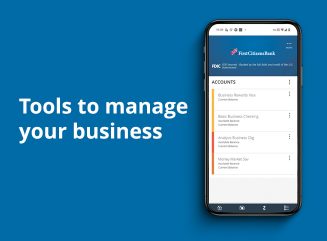
Digital banking for business
Seamlessly access all of your accounts from one place with First Citizens Digital Banking for business.
The modern business world is swimming in information—with technologies such as big data, AI, cloud computing and blockchain making it easier to extract potentially useful insights for your business. The key, though, is ensuring your employees have enough data literacy to properly use this information. But what is data literacy, and why is it so important?

The technology research firm Gartner defines data literacy as the ability to read, write and communicate data in context. This includes understanding the sources and constructs of data, the analytical techniques and methods used to create the data, and the ability to describe the result.
Some of the ways employees may demonstrate data literacy include:
In the past, data literacy used to be more of a technical field, focused on managing and producing the data itself. Companies looked for data scientist experts who knew techniques such as SQL, data extraction and information normalization and who were familiar with technologies such as parallel processing, big data analysis and R (a programming language).
Although this kind of data literacy can still help, new technologies and data platforms have embedded and automated much of the old techniques, opening sources of data to non-specialists. This also increased the sheer amount of information available, and it will only continue to grow with further developments in AI. As a result, data literacy has evolved from a specialty to something that can and should be shared across an organization.
Data can help your employees make more effective decisions, but only if they know how to use it properly. In a report from data analytics and software firm Qlik, 85% of employees who rate themselves as data literate say they're performing well at work, versus only 54% of the workforce in general. The same report found that large enterprises with strong cultures of data literacy had 5% higher enterprise values than those that didn't—a difference of hundreds of millions of dollars.
There are many practical opportunities throughout the workday where data-literate employees can help your organization become more agile and effective. For example, your procurement department may find vendor pricing patterns to better manage supply chain issues. Or your marketing team could review the metrics behind the return on ad spend, or ROAS, to find better uses for your advertising dollars.
Despite these possibilities, data literacy remains a rare skill. Only 25% of business decision-makers rate themselves as confident in it. They can try turning to their IT and business intelligence teams for support, but there's so much data to interpret and manage—they can't do everything. This is why it's crucial to invest in building data literacy for the rest of your staff.
There are myriad opportunities to build data literacy skills among your staff. Here are several ways to get started.
Above all, stress the real-life practical benefits of data literacy for both your company goals and the careers of your employees. If they can clearly connect the dots between improved data literacy and positive outcomes, they'll be far more likely to embrace it with enthusiasm.
Email Us
Please select the option that best matches your needs.
Customers with account-related questions who aren't enrolled in Digital Banking or who would prefer to talk with someone can call us directly.